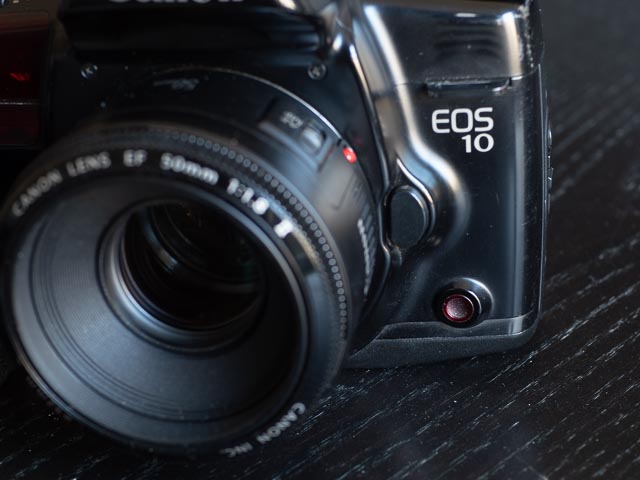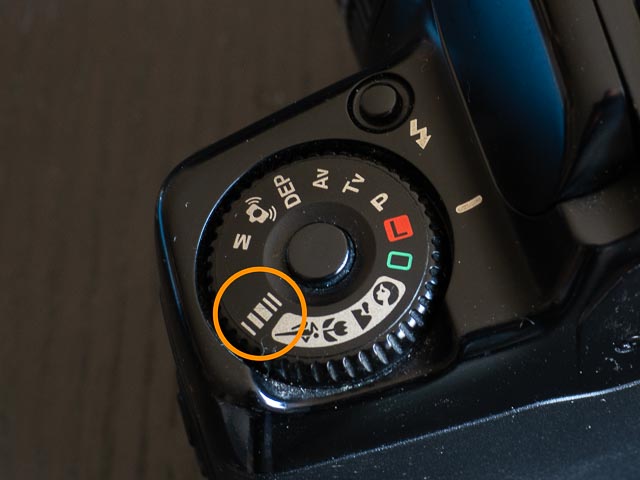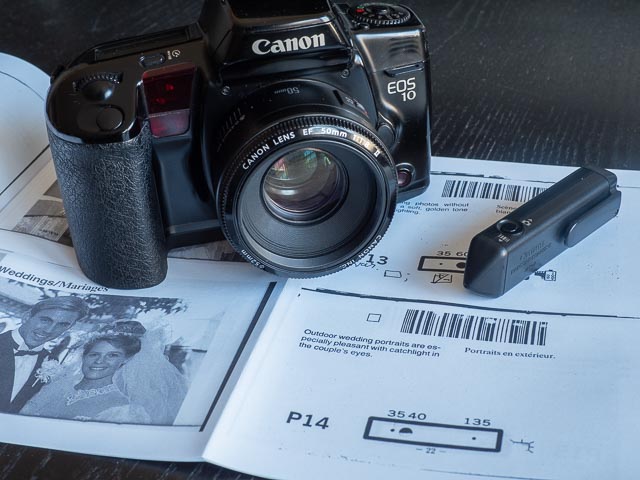Canon EOS 10

In March 1990 Canon launched the Canon EOS 10, the first of a new series of cameras that would replace their first generation of auto-focus SLRs, the 600 series. The EOS 10 (also known as the EOS 10 S in the Americas and the EOS 10 QD in Japan) sat at the top of Canon consumer range of SLR cameras… you had to move up to Canon's EOS 1 professional camera, launched the previous year in 1989, to top the EOS 10.
Canon always likes to have one or two headline new technologies in their top of the range consumer oriented cameras. Some of these were the latest refinements of technologies central to the modern auto-focus SLR experience. For example, the EOS 10 has a new auto-focussing system with a magnificent collection of 3 user-selectable focussing points (I shouldn't scoff… this was exciting stuff in 1990!). But there was often at least one rather bizare (not to mention highly impractical!) idea that would only ever be seen on one camera before being dropped like a hot stone.

 And on the EOS 10 this took the shape of a weird little reddish pimple on the lower right hand side of the front of the camera. It works with an equally mysterious symbol on the mode dial (here circled in orange). Neither are labeled, and without the manual you would never guess what they're for! But have no fear, gentle reader, I'm about to reveal all…!
And on the EOS 10 this took the shape of a weird little reddish pimple on the lower right hand side of the front of the camera. It works with an equally mysterious symbol on the mode dial (here circled in orange). Neither are labeled, and without the manual you would never guess what they're for! But have no fear, gentle reader, I'm about to reveal all…!
 The reddish pimple and the weird symbol on the mode dial were part of a sort of early "scene mode" system. You had to buy a scanner to make the system work, and the scanner came with a booklet containing dozens of oddly specific scenes a photographer might (just possibly!) come across. You had to set the mode dial to the barcode symbol, then scan the barcode next to the scen you were interested in, then place the end of the scanner next to the reddish pimple on the camera and wait a couple of seconds for the camera settings to be transferred to the camera. If all that sounds like a right faff that is only very slightly less tiresome than actually just applying the settings to the camera yourself, you'd be very right indeed!
The reddish pimple and the weird symbol on the mode dial were part of a sort of early "scene mode" system. You had to buy a scanner to make the system work, and the scanner came with a booklet containing dozens of oddly specific scenes a photographer might (just possibly!) come across. You had to set the mode dial to the barcode symbol, then scan the barcode next to the scen you were interested in, then place the end of the scanner next to the reddish pimple on the camera and wait a couple of seconds for the camera settings to be transferred to the camera. If all that sounds like a right faff that is only very slightly less tiresome than actually just applying the settings to the camera yourself, you'd be very right indeed! 
I bought the scanner just to see if I could get this system to work! Unfortunately it didn't come with the 100% essential booklet, but I was able to download the Canon EOS Photo Files Barcode Manual from the Camera Manual Library and print one out, which is what you see here. I was able to get it to work, but only after several attempts!
It should be a surprise to no-one that this daft system never saw the light of day again. Thought a similar concept is now seen on more-or-less every consumer oriented digital camera in the form of those scene modes. So if one was going to be kind to the twit that came up with this system, you could say they were just incredibly fore-sighted and ahead of their time! Of course modern digital cameras no feature large and colourful LCD monitors that allow the scenes to be browsed and selected on the camera itself, rather having to flip though a booklet looking for barcodes to scan.
This wasn't the last time Canon would introduce a system that the technology of the time just didn't make practical. The camera that replaced the EOS 10, the EOS 5, has a very sci-fi sounding eye-controlled system for selecting your desired focusing point… yes, that's right… you could just look at the a focussing point to select it! But I used the EOS 5 for many years as my main camera system, and I never used it. It had to be carefully and laboriously calibrated for each photographer's eye, which was also a tiresome faff, but more troublingly it only worked with the camera in landscape orientation. Again this system was never seen again, though if Canon could develop the technology to a usable point (i.e. either no calibration process, or a short and easy one, and it would have to work in both landscape and portrait orientation) I would sell a kidney to buy a camera with such a feature!

